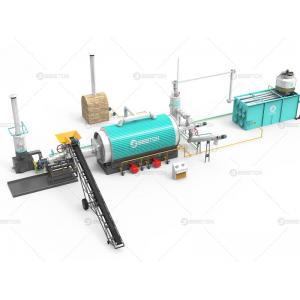Supplier: Beston Group
Contact person: Ms. lee
Position: seo
Address: NO.99 South University Road, Zhengzhou City, Henan Province, China.
Country: China
Phone: 18538232127 - Mobi: 18538232127
Pyrolysis Plant
Price: 45000
Principle of Pyrolysis:
Pyrolysis is a thermochemical decomposition process where organic materials such as plastics, rubber are heated in the absence of oxygen. The absence of oxygen prevents combustion and leads to the production of valuable by-products.
End Products of Pyrolysis:
Pyrolysis Gas (Syngas): This gas is a mixture of hydrogen, methane, carbon monoxide, and other hydrocarbons. Syngas is a versatile energy source used in various industrial applications, including heat and electricity generation.
Pyrolysis Oil (Bio-oil): A liquid product with a composition similar to crude oil, pyrolysis oil has potential applications as a fuel or feedstock for the production of chemicals and biofuels.
End Product Uses:
The main products of pyrolysis plant is pyrolysis oil, syngas.
Energy Generation: Pyrolysis gas, or syngas, is a valuable fuel that can be utilized for power generation. It can replace traditional fossil fuels in industrial boilers, turbines, and other energy-intensive processes.
Biofuel Production: Pyrolysis oil serves as a promising feedstock for the production of biofuels. With appropriate refinement processes, it can be transformed into biodiesel or other renewable fuels, reducing dependence on non-renewable resources.
Chemical Feedstock: Pyrolysis oil can be further processed to obtain valuable chemicals used in the manufacturing of various products, such as plastics, resins, and specialty chemicals.
Waste Management: Pyrolysis presents an eco-friendly approach to waste disposal. By converting organic waste into valuable products, it reduces the environmental impact associated with traditional landfilling or incineration.
Pyrolysis is a thermochemical decomposition process where organic materials such as plastics, rubber are heated in the absence of oxygen. The absence of oxygen prevents combustion and leads to the production of valuable by-products.
End Products of Pyrolysis:
Pyrolysis Gas (Syngas): This gas is a mixture of hydrogen, methane, carbon monoxide, and other hydrocarbons. Syngas is a versatile energy source used in various industrial applications, including heat and electricity generation.
Pyrolysis Oil (Bio-oil): A liquid product with a composition similar to crude oil, pyrolysis oil has potential applications as a fuel or feedstock for the production of chemicals and biofuels.
End Product Uses:
The main products of pyrolysis plant is pyrolysis oil, syngas.
Energy Generation: Pyrolysis gas, or syngas, is a valuable fuel that can be utilized for power generation. It can replace traditional fossil fuels in industrial boilers, turbines, and other energy-intensive processes.
Biofuel Production: Pyrolysis oil serves as a promising feedstock for the production of biofuels. With appropriate refinement processes, it can be transformed into biodiesel or other renewable fuels, reducing dependence on non-renewable resources.
Chemical Feedstock: Pyrolysis oil can be further processed to obtain valuable chemicals used in the manufacturing of various products, such as plastics, resins, and specialty chemicals.
Waste Management: Pyrolysis presents an eco-friendly approach to waste disposal. By converting organic waste into valuable products, it reduces the environmental impact associated with traditional landfilling or incineration.
SEND INQUIRY
Please fill in fully your information to send email
CATEGORY














 Agriculture
Agriculture